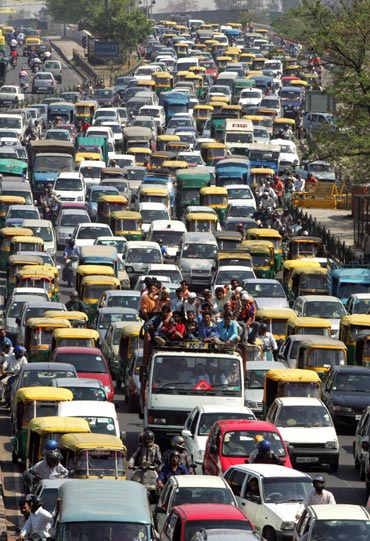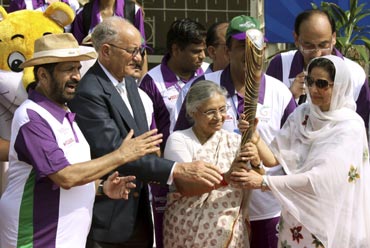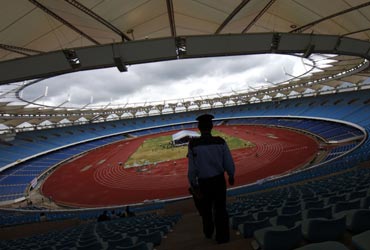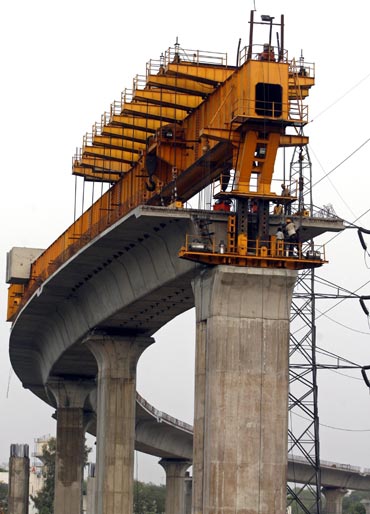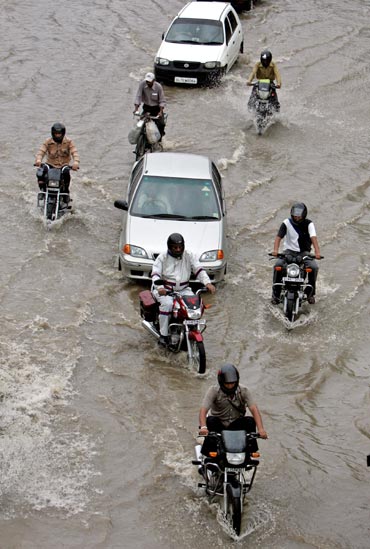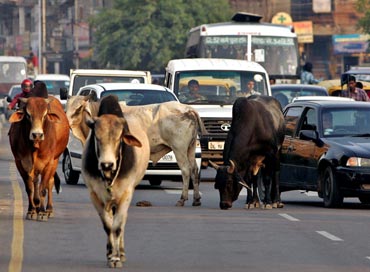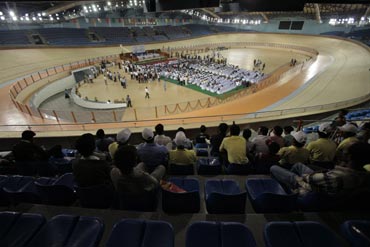 | « Back to article | Print this article |
Why Delhi's infrastructure seems to be falling apart
Delhi, the national Capital, was always a double-faced place but in the run up to the Commonwealth Games, it is acquiring a schizophrenic persona.
Poised to scale new heights as a world-class metropolis, it also appears to be falling apart. Soaring stadia with lights ablaze, swank villages for 8,000 athletes with private ice cream parlours, a metro burrowing its way to far corners and the T3, touted as the eighth largest terminal in the world. Ok, we got the message.
Why is it then that every time I enter the city, leave the house, try to catch an appointment in the suburbs or accomplish a day's jobs, I am beset with nightmarish traffic jams, long painful power cuts, waterlogged roads, (and) dangerously incomplete pavements, literally strewn with stumbling blocks?
Click NEXT to read on . . .
Why Delhi's infrastructure seems to be falling apart
Opposition councillors caused a ruckus, brought in the press and an inquiry has been ordered. If that's the state of the new HQ, it's no wonder that the vast municipality refuse dump at the end of my street is exactly as I have always known it -- a stinking mountain of garbage that takes days to clear.
The only new aspect to this putrefying mass is that it has now assumed the proportions of a minor Himalayan peak.
Click NEXT to read on . . .
Why Delhi's infrastructure seems to be falling apart
Delhi is savvy, sexy and smart -- that's if you listen to adherents such as Commonwealth Games organisers, the city's well-insulated ruling elite and its motherly chief minister (who, every time I turn on the car radio, is exhorting children to study harder and parents to keep calm during stressful school exams or elaborating on some tree-planting drive in adverts).
Delhi is also progressive and rich -- highest per capita income amongst small states and well-above-average social and quality-of-life indicators. Day-to-day life here, however, is not what it's cracked up to be.
Click NEXT to read on . . .
Why Delhi's infrastructure seems to be falling apart
Despite massive investment and higher levies (rates for power, water and property tax are all up) and the 70-day race to complete preparations for the Commonwealth Games, there is no evidence that Delhi's roads are less congested, electricity or water supply better managed or the Jamuna river less of a sewer than before.
Is it that Delhi can't cope with its embarrassment of riches? (Delhi Chief Minister) Sheila Dikshit has actually announced prizes -- by way of an extra month's salary -- for officials if building works are finished on time.
Click NEXT to read on . . .
Why Delhi's infrastructure seems to be falling apart
The city's coffers may run deep but its management is stuck in a quagmire of mismanagement and sloth.
A burgeoning metro and a fleet of low-slung, air-conditioned buses have made no appreciable difference to its clogged arteries.
Click NEXT to read on . . .
Why Delhi's infrastructure seems to be falling apart
Long the motor vehicle Capital of India, the city continues to add 1,000 cars a day to its streets. Privatisation of power has not reduced shortages -- outages were long and frequent through the summer months with markets covered in a miasma of generator fumes. Prices of diesel on the black market rocketed as supplies ran out.
And come the first monsoon showers, sections of the city routinely grind to a halt as roads begin to resemble rivers in spate.
Click NEXT to read on . . .
Why Delhi's infrastructure seems to be falling apart
A case in point is the decades-old project to clean up the Jamuna, Delhi's main waterway. The Commonwealth Games should have been the perfect moment to restore it as the city's central showpiece, a sign of the Capital's overall prosperity and health.
Click NEXT to read on . . .
Why Delhi's infrastructure seems to be falling apart
Despite crores of rupees spent, noisy public campaigns, endless committees and judicial interventions, it remains a parched eyesore and repository of much of Delhi's filth. Reason: there are 13 central and state bodies involved in its proposed transformation.
Like the ambitious overreacher who falls flat, Delhi talks big. The more things change, the more they remain the same.

